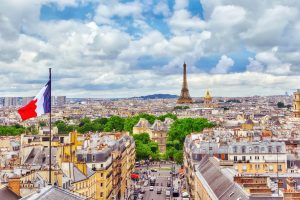The most romantic city in the world
Since the 1600s, Paris has been the most important place in the world for business, science, fashion, food, and diplomacy. It was a leader in art and science, so it was called the “City of Light” in the 19th century because of how it lit its streets. Before World War II, it might have been the world’s capital, like London. In 2022, Paris had the highest cost of living in the world, according to the Worldwide Cost of Living Survey by Economist Intelligence. The Paris Métro, which opened in 1900, is the city’s subway System. Every day, 5.23 million people. Paris is incredibly well known for its museums and famous buildings. Since 1991, the area along the Seine in the city’s center has been a UNESCO World Heritage Site.
Paris History
Paris has been around for over 2,000 years. Between 250 and 200 B.C., wealthy people from Paris moved there and started a fishing village on the island that is now the Île de la Ville. This island became the city center. The old Bastille’s name was Lutecia (Lutecia) in the past. Julius Caesar took over Paris in 52 AD. During the Roman Empire and into the early Middle Ages, Paris was a major city in the area. HUGH CAPET, Count of Paris, became King of France in 987. His descendants, the CAPETIANS, made Paris the capital of the country.
In 1355–1358, under the leadership of Étienne Marcel, the Parisian people, who were known for being bold and independent, declared themselves an independent commune. Paris was also a big part of the 1830 and 1848 revolutions. During the Franco-Prussian War of 1871, the French held the city for four months they gave up. In World War I, the Germans couldn’t get into Paris, but from 1940 to 1944, they ruled the city during World War II. During the student riots of 1968, there was more violence in Paris. Between the First and Second World Wars, Paris was the center of modern art and a draw for intellectuals, writers, and artists worldwide.
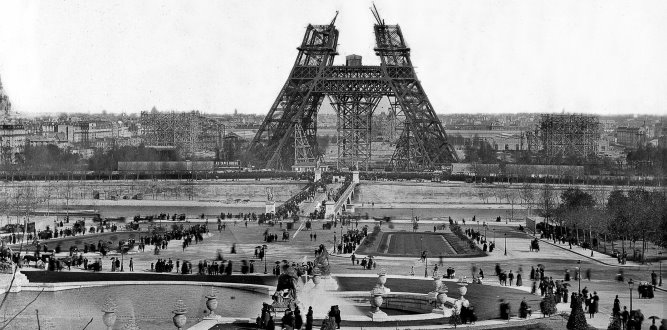
How To Get Into Paris
By Plane
Charles de Gaulle Airport
Charles de Gaulle Airport is the leading international airport in Paris. After Heathrow Airport, it has the second most passengers in Europe (London). It is also called Roissy-Charles de Gaulle.
There are three terminals at Charles de Gaulle Airport, and the second has several lobbies connecting. Except for Hall 2G, these three terminals are linked by a free light rail shuttle.
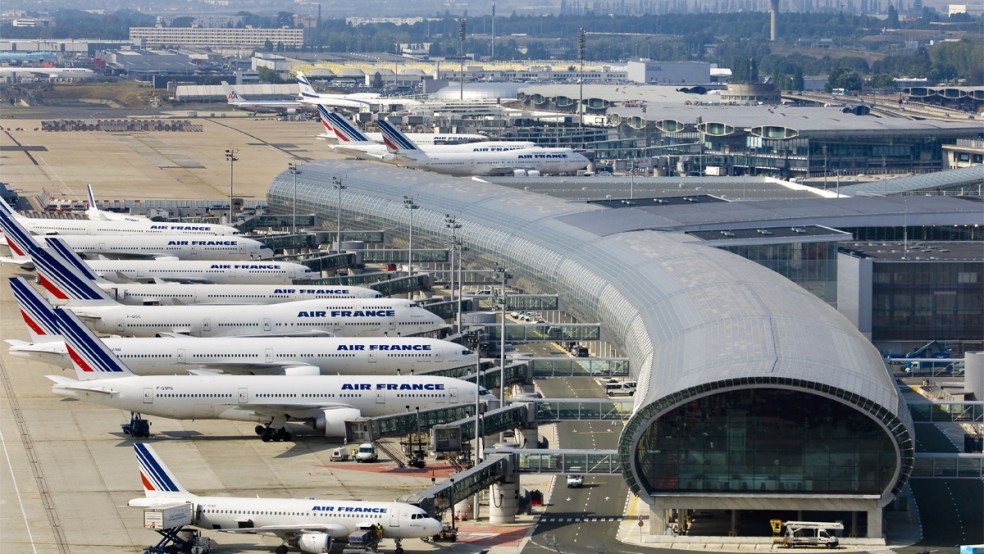
Orly Airport
Orly (ORY) is Paris’s second-biggest airport. A map of Orly Airport It has two stops: Sud (South) and Ouest (West) (West). The Orlyval, a free car shuttle, can take you from one terminal to the other. It was getting to and from the airport. Booking an airport transfer is the easiest and most relaxing way to get to the city center.

Beauvais Airport
Beauvais Airport, also called Beauvais-Tille Airport, is small in Tille, near the town of Beauvais and about 53 miles north of Paris. Low-cost and charter airlines like Ryanair often use Beauvais.

By Train
Tourists can train from Belgium, Spain, Holland, the United Kingdom, and Germany to get to Paris. Most of the time, train tickets cost more than plane tickets, and trains take longer. So, the best way to get to the french capital is to fly, but this is the best option for people who don’t want to fly.
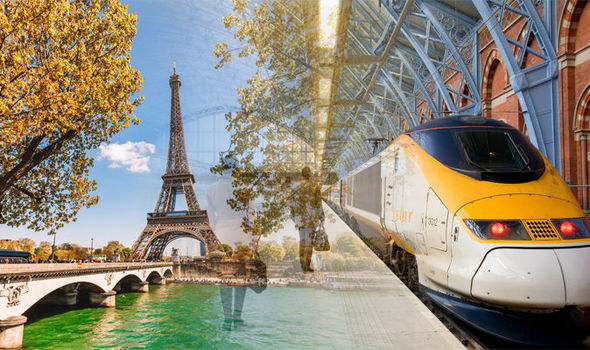
By Bus
You can also get around Europe by bus, which is easy and cheap. You can take a bus to Paris from most of Europe’s major cities. But the trip can be very long; sometimes, it takes more than 15 hours. The name of the bus station is Paris Gallieni, and it’s easy to get around the rest of the city from there.
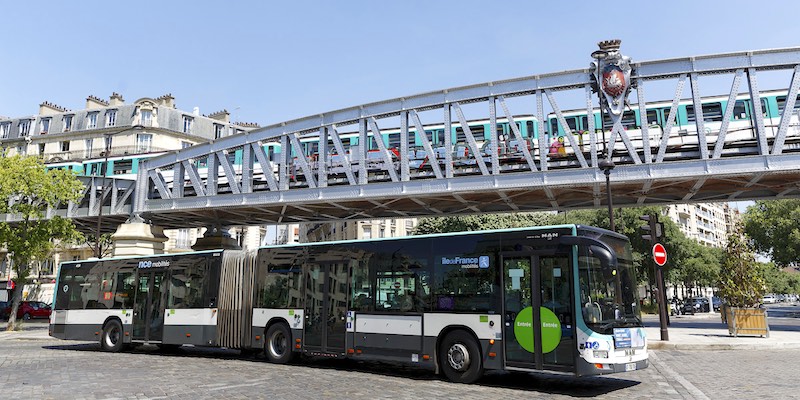
By Car
You might want to rent a car if you see more of France on your way to Paris. In the city center, is often very expensive to park on the street. It costs about €25 (US$26.40) per park.
Paris Climate
Paris has a mild climate, but the seasons are very different. Summers are warm, and winters are cold, but not too much of either. The amount of rain is about average and stays the same throughout the year. People know the city for its sudden rains. In Paris, the winters are about 40°F, and the summers are about 70°F. A sweater and a warm coat should keep you warm in the winter. But the weather in Paris can change quickly at any time of the year. A scarf or stole is useful and stylish as a fashion accessory.
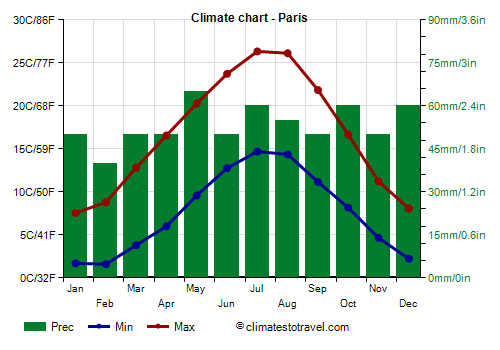


Top Sights In Paris
Eiffel Tower
The Eiffel Tower in Paris, France, is a latticed iron tower on the Champ de Mars. It is called the Eiffel Tower after the engineer Gustave Eiffel, whose company designed and built it. It was built from 1887 to 1889 as the centerpiece of the 1889 World’s Fair. Locals called it “La dame de fer.” The most expensive place to visit in the world is the Eiffel Tower. In 1964, it was named a Historical Monument, and in 1991, it became part of a UNESCO World Heritage Site. It stands 330 meters tall. It has a square base with sides that are 125 meters long. During its building, the Eiffel Tower grew taller than the Washington Monument, making it the world’s tallest artificial structure.

Musee d’Orsay
The Musée d’Orsay is a museum on the left bank of the Seine in Paris, France. It is housed in the former Gare d’Orsay, a Beaux-Arts railway station built between 1898 and 1900. The museum mainly houses French art dating from 1848 to 1914, including paintings, sculptures, furniture, and photographs. It houses the world’s largest collection of Impressionist and post-Impressionist masterpieces by artists including Berthe Morisot, Claude Monet, Édouard Manet, Degas, Renoir, Cézanne, Seurat, Sisley, Gauguin, and van Gogh. Many of these works were held at the Galerie Nationale du Jeu de Paume before the museum opened in 1986. It is one of the largest art museums in Europe.

Louvre Museum
The Louvre Museum in Paris, France, is the most-visited museum in the world and a famous place in history. Some of the most famous art pieces, like the Mona Lisa and the Venus de Milo, are kept there. It is one of the city’s most important landmarks and is on the right bank of the Seine in the 1st arrondissement. About 38,000 items from prehistory to the 21st century are displayed at any time over 72,735 square meters. The museum is in the Louvre Palace, which Philip II built from the end of the 12th century to the beginning of the 13th century.

Palais Garnier
The Palais Garnier, also known as the Opéra Garnier, is a 1,979-seat opera house on the Place de l’Opera in the 9th arrondissement of Paris, France. It was the primary theatre of the Paris Opera and the associated Paris Opera Ballet until 1989 when the new opera house Opéra Bastille opened on the Place de la Bastille. The company now uses the Palais Garnier mainly for ballet. This theatre has been in the monumental history of France since 1923. Palais Garnier has been called “probably the world’s most famous opera house, a symbol of Paris like Notre Dame Cathedral, the Louvre or the Sacré Coeur Basilica”. This is at least partly due to Gaston Leroux’s 1910 novel The Phantom of the Opera and, in particular, later adaptations of the novel used as the setting for films and the hit 1986 musical.
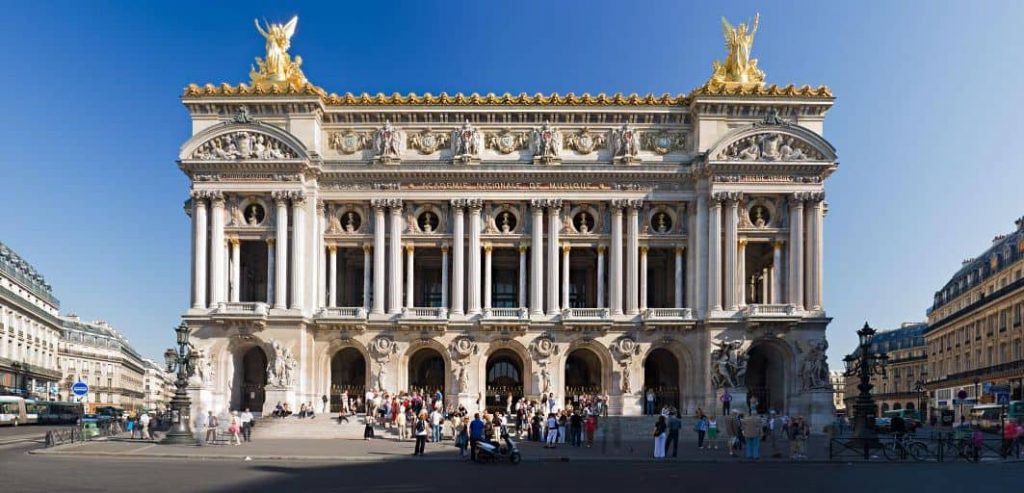
Notre Dame Cathedral,
One of the most recognizable things about Paris is Notre Dame de Paris, also called Notre Dame. A Roman Catholic cathedral is on the eastern half of Ile de la Cité. People all over France and Europe say it is one of the best examples of French Gothic architecture. The cathedral was started in 1163 and finished in 1345. The many sculptures and gargoyles on the roof make it a sight. After you’ve walked around the cathedral, go inside and climb the 387 steps to the top of the tower. Climbing to the top of the buildings is tiring, but you can see a wide view of the area and get close to the famous gargoyles.

Arc de Triomphe,
The Arc de Triomphe de l’Etoile is one of the most famous landmarks in Paris, France. It is at the western end of the Champs-Élysées, in the middle of what used to be called the Place de Letoile and is now called the Place Charles de Gaulle. The twelve paths come out from the conjunction to make up its “star.” The names of all French victories and generals are written inside and outside the Arc de Triomphe to honor those who fought and died for France in the French Revolutionary and Napoleonic Wars. The Arc de Triomphe is 50 meters tall, 45 meters wide, and 22 meters deep. The grand vault is 29.19 meters high and 14.62 meters wide.

The Centre Pompidou
Center Pompidou. Its full name is the Center National d’Art and Culture Georges-Pompidou. It is a group of buildings near Les Halles, rue Montorgueil, and Marais in the Beaubourg neighborhood of Paris’s 4th arrondissement. Richard Rogers, Sue Rogers, Renzo Piano, and Gianfranco Franchini worked together to make it in the style of high-tech architecture. The Bibliothèque Publique information, a large public library, is there. Musée National d’Art Moderne, the biggest modern art museum in Europe, and IRCAM, a center for research into music and sound. Because of where it is, the area calls the center of Beaubourg.
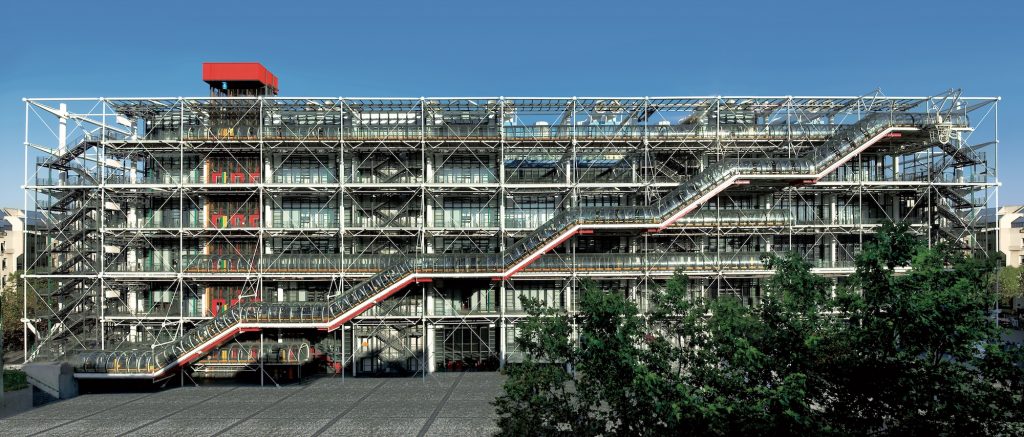
Luxembourg Gardens
of Jardin du Luxembourg, also called the Luxembourg Gardens or the Sénat Gardens was in the 6th arrondissement of Paris, France. It is also called the Jardin du Sénat. In 1612, Marie de Medici, the widow of King Henry IV, built the Luxembourg Palace as her new home. This was the first step in making the garden. The French Senate, which meets in the palace, owns the park now. It is famous for its lawns, tree-lined promenades, tennis courts, flowed r beds, model sailboats in the Grand Basin, and the beautiful Medici Fountain, which was built in 1620.

City Details
Paris, the country’s largest city and capital, is in the north-central part of France. Around 7600 BCE, people were living where the city is now, along the Seine River about 233 miles (375 km) upstream from where the river empties into the English Channel (La Manche). From the island (the Île de la Cité), the city has grown far beyond both sides of the Seine.

Paris is in the middle of a rich agricultural area called the Paris Basin. It is also one of the eight departments that make up the Île-de-France administrative region. It is by far the most important place for business and culture. Area city, 41 square miles (105 square km); metropolitan area, 890 square miles (2,300 square km). City population in 2012: 2,265,886; urban agglomeration population in 2015: 10,858,000.
Paris currency: Euro
Paris city area: 105.4 km2 (40.7 sq mi)
Urban (2020) 2,853.5 km2 (1,101.7 sq mi)
Metro (2020) 18,940.7 km2 (7,313.0 sq mi)
Paris time zone: UTC+01:00 (CET)
Summer (DST) UTC+02:00 (CESTEST)
Paris official language: French
Paris (France) dials Code:+33
Population (Jan. 2019)[2] 2,165,423
Density 21,000/km2 (53,000/sq mi)
Urban (2019[3]) 10,858,852
Getting around in Paris
Walking and taking the metro are the best ways to get around Paris. The beautiful arrondissements are almost made for walking. Still, is a big city, so if you need to go far, you should take the fast metro. The Régie Autonome des Transports Parisiens (RATP), which is in charge of the metro, also runs several bus routes throughout the city. People who fly to Paris can land at Charles de Gaulle Airport (CDG), about 22 miles northeast of the city center, or Paris Orly Airport (ORY), about 11 miles south of the city.
On Foot
Walking is the best way to get around since most tourists book hotels in the center of lovely cities. Walking is the best way to see the city’s famous buildings and its often magical atmosphere. But if your home is a bit further away or if you have to walk a few miles to get to the best sights, you might want to take the metro instead, which is a bit cheaper and faster.
By Metro
The metro is part of the city’s RATP public transportation system. It is easy to get to, affordable and has 16 routes throughout the metropolitan area. You can buy one ticket at a time. If you know how often you take public transportation in a day, you can use the ticket book for the metro, RER trains in zone 1, buses, and more. A Mobilis pass is better if you don’t know how much ground you will cover. Every day, the metro runs from 6 a.m. to 12:30 p.m. Make sure you know the Metro’s exact schedule before you Go.

By Train,
Up to five express lines run from the center of Paris to the suburbs on the Réseau Express Régional (RER) trains. Both of Paris’s airports are served by the RER trains, which also take tourists to the city’s heart. The RER C train is the best way to get to the Palace of Versailles unless you want to take a pricey taxi or drive. You can get to smaller towns and places outside the city on the RER train, like Disneyland Paris. At any RER or Metro station, you can buy a ticket. For any trip outside of zone 1, the price of an RER a the key is based on how many stops you make.

By Bus,
RATP runs 59 bus routes in Paris and the areas around it. You can pay for bus rides with t+ tickets and metro passes. A bus ride costs the same as a metro ride, which costs 1.90 euros (about $2.50) unless you buy your ticket on the bus. Even though the bus is slower than the metro, it has more scenic routes and runs for long hours. Bus times vary by route, but most run from 7 a.m. to 8:30 p.m., Monday through Saturday.

Taxi
Taxis are everywhere. On the top of official Paris taxis is a sign that says “Taxi Parisien.” The meter starts at 2.60 euros, about $3, and each kilometer driven costs more. You can call for a taxi on the street, but it’s easier to wait in a taxi line that goes all over the city. Taxis G7, Alpha Taxis, and Taxis Bleus are the leading taxi company in Paris. The Uber app is also available.

By Car,
It would be best if you didn’t drive in Paris unless you plan to explore outside the city. Heavy traffic, road signs that can be confusing, and a lack of parking spots are the usual things that make driving a nightmare. Still, you can rent cars, called “car hires,” at the airports and major train stations.
Paris Cuisine
What do you think you should eat in Paris, France? French food is known worldwide for its delicious flavors, which come from traditional recipes and high-quality ingredients. Some foods are common all over France, while others are only in Paris. Here are some of the most popular things to eat in Paris:
- Escargots: A National Symbol.
- Macarons.
- Steak tartar.
- Cheese.
- Onion soup’s
- Croissants: (a butter croissant for breakfast)


Best Cafes and Restaurants in Paris,
France has one of the most famous cuisines in the world, and Paris has some of the best restaurants and Chefs in the world. Even so, there are ways to eat for any amount of money. There’s something for everyone, from restaurants with Michelin stars to hidden cafes to great food you can take away. Among the best ones we liked were the following:
- Mastino (Italian)
- Scandal (Eco cafe)
- Holybelly 5 (Brunch)
- La Cantine de Sam (Delicious vegetarian food)
- Zia (Brunch)
- Pink Mamma (Italian).

Paris Nightlife.
What do you think you should eat in Paris, France? French food is known worldwide for its delicious flavours, which come from traditional recipes and high-quality ingredients. Delicious food in Paris. Some foods are common all over France, while others are only in Paris. Here are some of the most popular things to eat in Paris. You can eat like a local in Paris by eating famous dishes, the city’s favourite street food, or delicious desserts.
- Campo Santa Margherita
- Venice Jazz Club
- Cannaregio’s Canalfront
- Skyline Rooftop Bar
- Casinò di Venezia
- Nightclubs of Mestre
- Paris Accommodation
Le Marais is the best place to stay in Paris if you want to be close to everything. You’ll be close to trendy shops and restaurants, and you can walk or take the metro to most places of interest. But most places to stay won’t be less than €80 a night, so you might also want to look at other nearby areas.


Approximate Budget
It would help if you planned to spend about €184 ($195) per day on your trip to Paris. This is the average daily cost based on what other tourists have spent. Also, a hotel room for two people in Paris costs an average of 242 Euros ($256). So, two people going to Paris for a week will spend an average of €2,572 ($2,726). These average travel prices were all collected from other travellers to help you plan your travel budget.
Conclusion
Paris, France, is called “The City of Light,” “City of Romance,” and “Culinary Capital of the World.” Each year, more than seven million people go there. Paris, France, is one of the most amazing places you will ever see. There are so many amazing things to know that you won’t get bored.
FAQs
What is Paris famous for?
One of the most beautiful places in the world is Paris. It is known worldwide for the Louvre museum, Notre Dame cathedral, and the Eiffel tower. People say that it’s a romantic and cultural city. The city is also known for its good food and cafés with outdoor seating.
Is Paris a cheap city?
One of the most expensive places to visit in Europe is Paris. Even though there are cheap and free things to do in Paris, the city is best known for its art galleries and fine dining, which you won’t miss.
Why is Paris called the city of love?
People call Paris “the City of Love” because it feels so romantic. The City of Love isn’t just a random name for Paris. Anyone who has been to the French capital would use that name to describe it because of how romantic it feels there. What’s going on?
What month is best to go to Paris?
You’ll see many people from May to September, but in July, you’ll see the most (followed closely by June and August). If you want to avoid crowds, the best time would be between October and April. The best times to visit Paris with a few people are in October and April when the weather is warm.
What food is famous in Paris?
Croissants, macarons, baguettes and croque-monsieurs: Paris’s best culinary specialities!
- The baguette.
- Cheeses from the Paris region.
- The Opera.
- The croissant.
- The croque-monsieur.
- The macaron.
- Entrecôte steak and chips.
- Parisian honey.
Is it free to climb the Eiffel tower?
To get into the Eiffel Tower, you need a ticket, a tour voucher, or confirmation from an Eiffel Tower restaurant that you have a reservation. There are four different kinds of tickets, depending on how many floors you want to see and if you wish to ride or climb.
What do you call a Paris person?
Parisian (plural Parisians) A person born in, or is a citizen or inhabitant of, Paris, France.
How many days in Paris is enough?
Plan on spending at least three days in Paris if you want to get a good feel for the city, see some of the most important sights, and get to know the central neighbourhoods. But if you’re going to have fun, I’d suggest starting with seven days in Paris, especially if it’s a place you’ve wanted to go to for a long time.
Is food expensive in Paris?
Meal prices in Paris can vary, but it costs €31 per day to eat in Paris on average. Based on how much other travellers have spent, a typical meal out in Paris should cost around €12 per person. Most of the time, breakfast costs less than lunch or dinner.
Paris is in which country?
Paris is the largest city in France and its capital. It is in the north of the country on the Seine River. It is in the middle of the Île-de-France region, also called the “Paris Region.”


